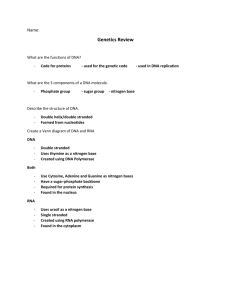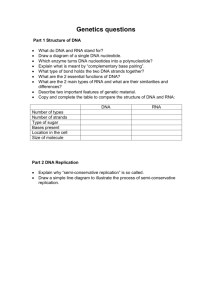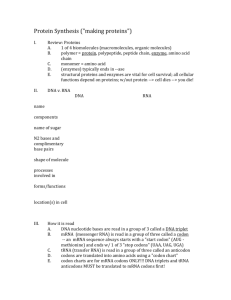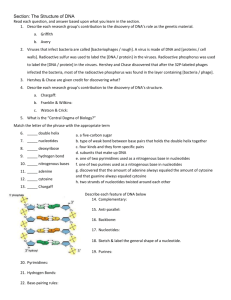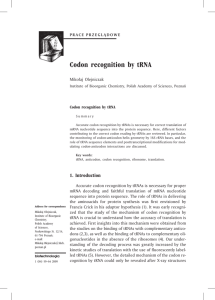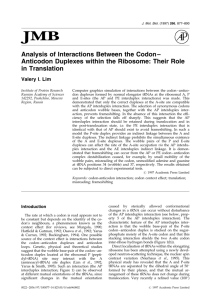doc
advertisement
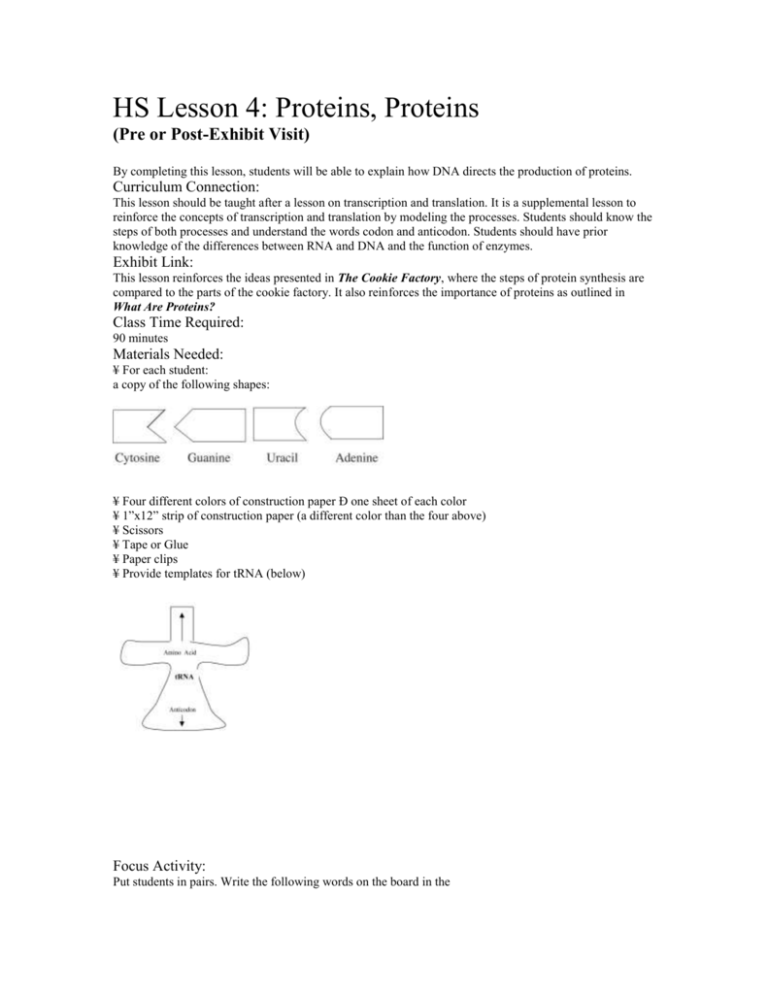
HS Lesson 4: Proteins, Proteins (Pre or Post-Exhibit Visit) Objective: By completing this lesson, students will be able to explain how DNA directs the production of proteins. Curriculum Connection: This lesson should be taught after a lesson on transcription and translation. It is a supplemental lesson to reinforce the concepts of transcription and translation by modeling the processes. Students should know the steps of both processes and understand the words codon and anticodon. Students should have prior knowledge of the differences between RNA and DNA and the function of enzymes. Exhibit Link: This lesson reinforces the ideas presented in The Cookie Factory, where the steps of protein synthesis are compared to the parts of the cookie factory. It also reinforces the importance of proteins as outlined in What Are Proteins? Class Time Required: 90 minutes Materials Needed: ¥ For each student: a copy of the following shapes: ¥ Four different colors of construction paper Ð one sheet of each color ¥ 1”x12” strip of construction paper (a different color than the four above) ¥ Scissors ¥ Tape or Glue ¥ Paper clips ¥ Provide templates for tRNA (below) Focus Activity: Put students in pairs. Write the following words on the board in the following order: SUGAR, PROTEIN, DNA, FATS, WATER With their partner, have students list the items from most abundant to least abundant in the human body. (They will not know the answer, but should just give it their best guess.) Lesson Steps: 1. Ask students about their answers. In discussing their answers make sure that students know that the most abundant molecule in the body is water; second is protein. The relative amounts of DNA, sugar, and fats vary depending on the person, but you could discuss which one they suspect would be most abundant and why. 2. Discuss the importance of proteins. Many proteins act as enzymes, some serve as passageways into the cell, and some help provide structure in a variety of places in the body. 3. Review the processes of transcription and translation. Stress that DNA is so important because it directs the production of proteins. 4. Write the following sequence on the board, and ask students if it is DNA or RNA: TACGGCACGATT. Have students copy the DNA sequence onto a piece of paper. 5. Review the process of transcription. Have students write down the RNA sequence that would come from the DNA on the board. 6. Pass out the supplies: base templates, paper, scissors, and glue or tape. Using their templates of the four RNA nitrogen bases, have students cut out the correct number of shapes that they need for their RNA strand. Use a different color for each different type of base. In order, have them tape the bases to the 1”x12” strip. (The sequence should be AUGCCGUGCUAA). They have just completed transcription. 7. Use a picture of a tRNA molecule to review with students what the tRNA molecule does. Have them cut out three tRNA-shaped molecules to help conduct translation. 8. Review what an anticodon is. For the first codon of AUG, ask students what the anticodon would be. Then, have them cut out a U an A and a C and tape them at the bottom of the tRNA molecule. Tape the bases so they will bind to the mRNA strand. 9. Ask what would be found at the top of the tRNA. Use the codon table in their books, and have them find that AUG is the codon for the amino acid methionine. Have them cut out a square and write methionine and paper clip it to the top of the tRNA molecule. 10. Repeat Steps 9 and 10 with the second codon. The anticodon should now be GGC and the amino acid should be glycine. With two tRNA molecules bound to the mRNA, tape or glue the first amino acid to the second amino acid. Once they have done this, that first tRNA is free to leave. Put it aside. 11. Repeat Steps 9 and 10 for codon three: anticodon AGC and amino acid cysteine. Staple or glue the first two amino acids to the third amino acid. Now, the second tRNA is free to leave. 12. The students should notice that the last codon is a stop codon. There is no tRNA molecule for a stop codon, so the process is now complete. Release the protein from the last tRNA. Extensions & Modifications: ¥ For lower level students, make the mRNA sequence and tRNA molecules for the students, and allow them to simply model the steps. ¥ For more advanced students, type up a set of instructions for the students to follow and do the process more independently. ¥ To speed up the process, cut out the bases for the students and make the tRNA molecules ahead of time. They should still build the mRNA strand on their own. Writing Prompts/Potential Discussion Questions: 1. Compare the steps of transcription and translation to the processes that take place within a cookie factory. Make analogies for each step along the way. 2. If you are made up of thousands of unique proteins in your body, what conclusions can you make about your DNA sequence? What could happen if your DNA sequence were disrupted in some way? Why might it be a good idea to use mRNA to direct protein synthesis? Rather than copying DNA directly? 3. Discuss the importance of each tRNA molecule carrying a specific amino acid. What would happen if the amino acid were not always the same for each anticodon? 4. What could happen if the DNA that resulted in a start or stop codon were damaged or mutated into something else? Additional Resources: Protein Synthesis — Power Point Slide Show http://www.ccds.charlotte.nc.us/richards2/Protein%20Synthesis/sld001.htm This gives a good overview of the whole process, but the graphics also represent very well the process that the students are modeling in this activity. Textbook: Miller, Kenneth and Joseph Levine. Biology. Prentice-Hall, 2002. National Standards Addressed: Standard C — The Molecular Basis of Heredity In all organisms, the instructions for specifying the characteristics of the organism are carried in DNA, a large polymer formed from subunits of four kinds (A, G, C, and T). The chemical and structural properties of DNA explain how the genetic information that underlies heredity is both encoded in genes (as a string of molecular "letters") and replicated (by a templating mechanism).


